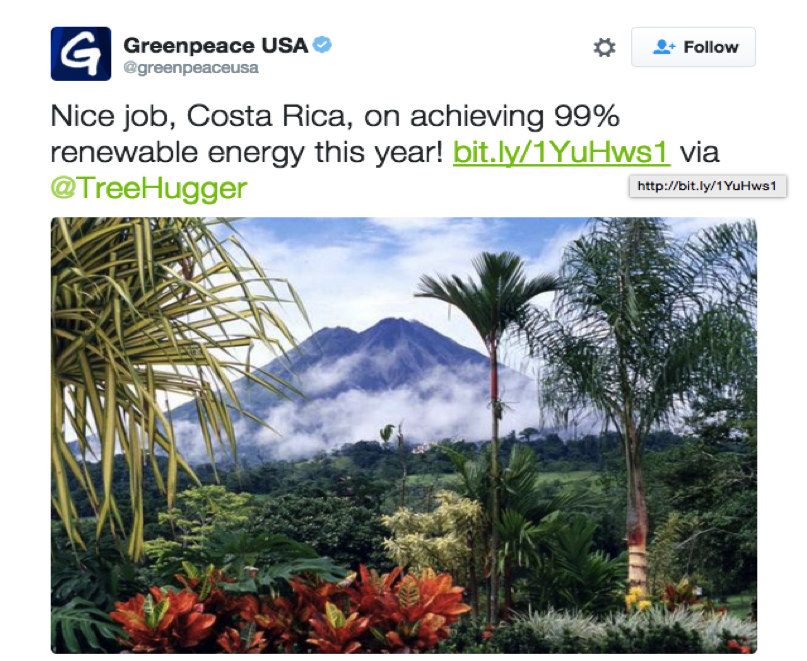Costa Rica’s achievements in perspective
Posted in Comment, Policy on 02/04/2016 12:15 pm by Suzanna Hinson
Costa Rica has been the subject of many renewable headlines in the past year and has been heralded as an example of the sustainable future that all countries should strive for. The main claim was that of 99% of their energy in 2015 coming from renewables – a truly unbelievable feat.
But is it truly unbelievable; literally too good to be true? Put simply – yes. A mismatch of words has exaggerated Costa Rica’s success. These words are key and yet often and increasingly confused: energy and electricity. As Costa Rica News reports, on December 30, the Costa Rican Institute of Electricity claimed “99% renewable electricity generation” during 2015. However when reported in the global press, this quickly became 99% of energy as Greenpeace’s picture below shows.
But energy is not electricity. In fact, electricity is often a very small portion of a countries total energy use. In Costa Rica, only 18% of demand was in electricity, meaning only 17.8% of Costa Rica’s energy was renewable. This is commendable but it is also below the world’s average of 19.1% (in 2013) and far below the celebrated 99%.
A second key headline was that Costa Rica had gone 75 days and only used renewable electricity. This is more believable with the fact that 99% of electricity in the entire year was renewable. But even this headline has its limits between the lines. As the Guardian reported, Costa Rica’s ability to meet its green electricity targets is highly dependent on the climate that as we all know is getting increasingly less dependable. The vast majority (80%) of Costa Rica’s renewable capacity is generated through hydro-power. The countries many rivers provide this power but the rivers themselves are powered by rainfall. Recently, high rainfall has filled the dams allowing them to power the nation. But not long ago, the country was racked by drought and hydroelectric power could no longer be depended upon. Ironically therefore, Costa Rica’s climate-sensitive electricity generation could be increasingly undermined in future as the climate changes and rains become more erratic.
It is important not to belittle the effort of Costa Rica though. Their achievements have been exaggerated by the global media, but the ambition behind them is highly commendable. Not only in energy but also in tourism and the use of their plentiful resources, the country is highly dedicated to environmentalism and is aiming for carbon neutrality by 2021, which – if achieved – would make it a world leader in decarbonisation.
Despite these achievements and plans, it is also important to not use Costa Rica as an example for the rest of the world to follow as many of the exaggerated headlines suggest. Though their environmentalist mentality should be replicated globally, their methodology is not applicable to much of the globe. Costa Rica has a relatively small population of only 5 million and no major energy intensive industry, making it relatively easy to power. Up scaling to provide for all the worlds people and industry would require far more than hydropower can provide. Hydro-power is already the world’s largest renewable but has its own limitations, with issues for habitats and displaced peoples, and suitable sites are starting to be used up. Instead, a global environmentalist mentality would use all of the world’s resources, in the correct places, to the best advantage. Solar, wind, tidal, wave, sustainable biomass, nuclear and carbon capture and storage, all have a place in achieving not 90 % but 100% clean generation of not electricity but energy in not just one nation, but the entire world.



